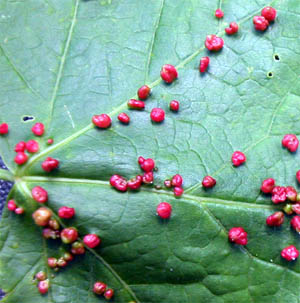Common Maple Galls
ENTFACT-404: Common Maple Galls | Download PDF
by Lee Townsend, Extension Entomologist
University of Kentucky College of Agriculture
Galls are irregular plant growths which are stimulated by the interaction between plant hormones and growth-regulating chemicals produced by some insects and mites. The maker receives food and protection from the gall tissue. Gall populations fluctuate from year to year, occasionally becoming very abundant. Despite the aesthetic impact and premature leaf drop during outbreaks, tree vigor is not affected significanltly.
Gall makers must attack at a particular time in the year to be successful. Otherwise, they may not be able to stimulate gall production. Generally, initiation of leaf galls occurs around "bud break" or as new leaves begin to unfold in the spring. Once the symptom or gall appears, the organism is protected in the structure, making remedial actions ineffective.
Several types of mites can cause maples to produce three types of galls:
- rounded bladder galls
- narrow spindle galls
- felt-like erineum galls
Most galls occur on early spring foliage that develops near the trunk and on larger branches. Additional galls are formed on newly developing leaves later in the summer but mites are most active early in the season. Galls usually form on a small proportion of the leaves and tree health is unaffected.

Maple Bladder Galls
Maple Bladder Galls
Maple bladder galls occur on silver and red maples. They are irregular, spherical growths that are usually found on the upper surfaces of the leaves. These hollow, purple-green to red structures are attached to the leaves by short hollow stems. Large numbers may cause infested leaves to "cup" and to drop prematurely. The single mite inside each gall feeds and lays eggs. Activity usually ends in July and the mites pass the winter under bud scales, moving back to leaves as they open in the spring. An application of carbaryl (Sevin) to the lower leaf surface when the leaves are about 1/4 expanded and again 10 days later may reduce infestations.
Felt or Erineum Galls
Felt or erineum galls are produced by several species of mites. These appear as light green to yellow-green velvet-like patches on the underside of leaves.
Maple Spindle Galls
Maple spindle galls occur most frequently on the upper surface of sugar maple leaves. The life cycle is similar to that of the maple bladder gall.
Eyespot Midge Gall
The most striking gall on red maple, and occasionally sugar and silver maple, is caused by a small fly (midge). The small fly lays its eggs in the undersurface of leaves. The maggot that hatches from the egg develops quickly, producing a growth regulating-hormone which causes the development of bright red and yellow rings around the gall, usually in June. The 1/4" diameter area later turns brown. The maggot inside the gall completes its development in about 10 days. It then drops to the ground to pupate and transforms into the adult. There is one generation each year.
Application of some formulations of carbaryl (Sevin, etc) are labeled for control of mites on shade trees. However, because the galls do not affect tree health, applications are not necesary.
Issued: 3/93
Revised: 7/19
CAUTION! Pesticide recommendations in this publication are registered for use in Kentucky, USA ONLY! The use of some products may not be legal in your state or country. Please check with your local county agent or regulatory official before using any pesticide mentioned in this publication.
Of course, ALWAYS READ AND FOLLOW LABEL DIRECTIONS FOR SAFE USE OF ANY PESTICIDE!
Images: University of Kentucky Entomology.
